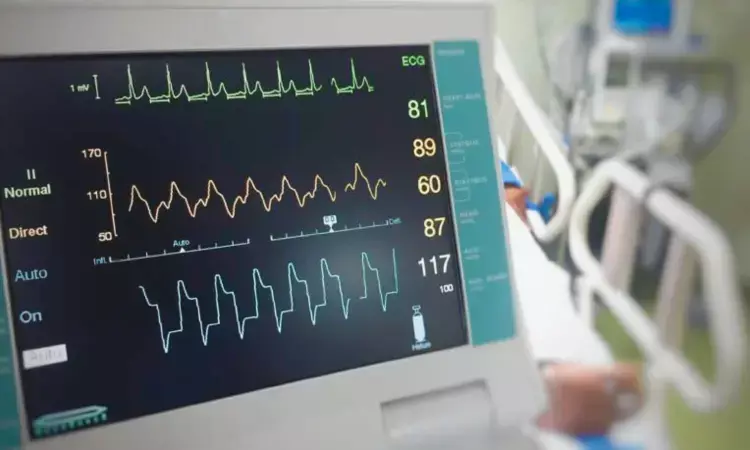- Home
- Medical news & Guidelines
- Anesthesiology
- Cardiology and CTVS
- Critical Care
- Dentistry
- Dermatology
- Diabetes and Endocrinology
- ENT
- Gastroenterology
- Medicine
- Nephrology
- Neurology
- Obstretics-Gynaecology
- Oncology
- Ophthalmology
- Orthopaedics
- Pediatrics-Neonatology
- Psychiatry
- Pulmonology
- Radiology
- Surgery
- Urology
- Laboratory Medicine
- Diet
- Nursing
- Paramedical
- Physiotherapy
- Health news
- Fact Check
- Bone Health Fact Check
- Brain Health Fact Check
- Cancer Related Fact Check
- Child Care Fact Check
- Dental and oral health fact check
- Diabetes and metabolic health fact check
- Diet and Nutrition Fact Check
- Eye and ENT Care Fact Check
- Fitness fact check
- Gut health fact check
- Heart health fact check
- Kidney health fact check
- Medical education fact check
- Men's health fact check
- Respiratory fact check
- Skin and hair care fact check
- Vaccine and Immunization fact check
- Women's health fact check
- AYUSH
- State News
- Andaman and Nicobar Islands
- Andhra Pradesh
- Arunachal Pradesh
- Assam
- Bihar
- Chandigarh
- Chattisgarh
- Dadra and Nagar Haveli
- Daman and Diu
- Delhi
- Goa
- Gujarat
- Haryana
- Himachal Pradesh
- Jammu & Kashmir
- Jharkhand
- Karnataka
- Kerala
- Ladakh
- Lakshadweep
- Madhya Pradesh
- Maharashtra
- Manipur
- Meghalaya
- Mizoram
- Nagaland
- Odisha
- Puducherry
- Punjab
- Rajasthan
- Sikkim
- Tamil Nadu
- Telangana
- Tripura
- Uttar Pradesh
- Uttrakhand
- West Bengal
- Medical Education
- Industry
Stress ECG positivity may reveal coronary microvascular dysfunction in patients with ANOCA

UK: A recent study revealed that ischemia on electrocardiographic stress testing (EST) is highly specific to an underlying ischemic substrate in patients with angina with nonobstructive coronary arteries (ANOCA).
The findings, published in the Journal of the American College of Cardiology, challenge the traditional belief that EST has a high false positive rate.
"A standard Bruce-protocol exercise test demonstrated 100% specificity for coronary microvascular dysfunction (CMD), verified against invasive coronary assessment as a reference, with all patients showing ischemic ECG changes during the exercise test also having confirmed CMD," the researchers reported.
"Using endothelium-independent and endothelium-dependent CMD as the reference standard, the false-positive rate of the exercise tests was 0% in a small cohort."
Exercise electrocardiographic stress testing represents a ubiquitous, noninvasive, and low-cost functional test for the evaluation of patients with new-onset angina. It has been historically been validated against the demonstration of obstructive coronary artery disease (CAD). However, myocardial ischemia can occur due to coronary microvascular dysfunction in the absence of obstructive CAD. Haseeb Rahman, St. Thomas' Hospital in London, and colleagues aimed to evaluate the specificity of EST to detect an ischemic substrate against the reference standard of coronary endothelium-independent and endothelium-dependent microvascular function in patients with ANOCA.
The study included patients with ANOCA who underwent invasive coronary physiological assessment using acetylcholine and adenosine. CMD was defined as impaired endothelium-independent and endothelium-dependent function. a standard Bruce treadmill protocol. Ischemia was defined as the appearance of ≥0.1-mV ST-segment depression 80 ms from the J-point on electrocardiography. The study was powered for detection of specificity ≥91%. A total of 102 patients were enrolled (65% women, mean age 60 ± 8 years).
Based on the study, the researchers reported the following findings:
- Thirty-two patients developed ischemia (ischemic group) during EST, whereas 70 patients did not (nonischemic group); both groups were phenotypically similar.
- Ischemia during EST was 100% specific for CMD.
- Acetylcholine flow reserve was the strongest predictor of ischemia during exercise.
- Using endothelium-independent and endothelium-dependent microvascular dysfunction as the reference standard, the false positive rate of EST dropped to 0%.
"Using comprehensive coronary ischemic physiology as the reference standard, ECG changes during exercise was highly specific for CMD on our patient cohort," the researchers wrote. "The finding is important and highlights the limitations of obstructive CAD use as a reference standard to evaluate the accuracy of noninvasive imaging modalities."
Reference:
Sinha A, et al "Rethinking false positive exercise electrocardiographic stress tests by assessing coronary microvascular function" J Am Coll Cardiol 2024; DOI: 10.1016/j.jacc.2023.10.034.
Dr Kamal Kant Kohli-MBBS, DTCD- a chest specialist with more than 30 years of practice and a flair for writing clinical articles, Dr Kamal Kant Kohli joined Medical Dialogues as a Chief Editor of Medical News. Besides writing articles, as an editor, he proofreads and verifies all the medical content published on Medical Dialogues including those coming from journals, studies,medical conferences,guidelines etc. Email: drkohli@medicaldialogues.in. Contact no. 011-43720751


